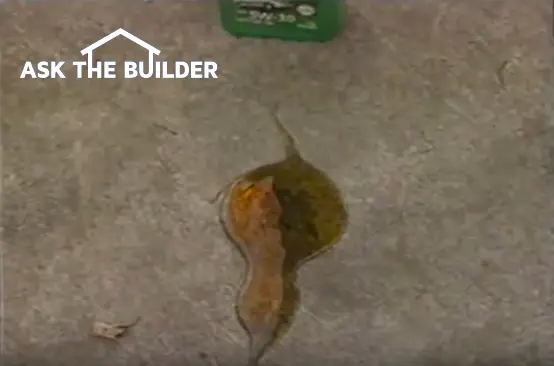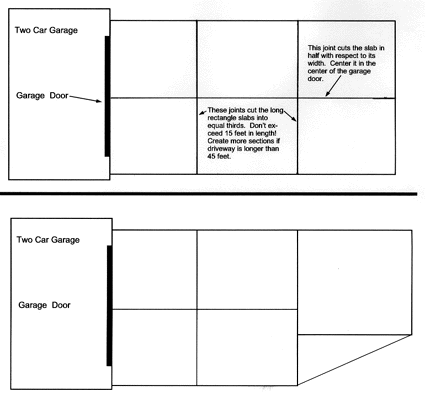Concrete Scaling & Deicing Salts
I knew that when I wrote this column and bulletin set that I would upset many a concrete mason. It never fails. What disturbs me the most is not the criticism I receive, but the failure on the part of the contractors to admit their lack of understanding of the subject. Just this morning, I received an email from a concrete contractor. He told me that my column was inaccurate. I wrote back indicating that my facts were derived from the latest scientific data from both the Portland Cement Association and the American Concrete Institute. I then asked him from where he obtained his data. No response! It makes you wonder what other facts about building and remodeling might be twisted in his head.
Writing this column has allowed me to really educate myself about the products and techniques used in the residential building industry. When I was still pounding a hammer each day, instead of this keyboard, I didn't have time to research facts. I was in the dark about quite a few things. You as a homeowner fight this battle everyday with contractors. Fortunately, the growth of the Internet has made it easy for you and contractors to obtain accurate information very quickly. I hope, for your sake, that you are taking advantage of this wonderful new media form.
Deicing Salt & Concrete
Let's set the record straight. Deicing salts will NOT harm concrete that is made correctly, placed correctly, and finished properly. Those three conditions cover much ground. For example, the concrete contractor at your house may do the job right. However, he may have been sold defective concrete. The likelihood of this is small. However, if you are planning on doing a large outdoor pour, I would give serious consideration to paying several hundred dollars for an insurance policy.
Concrete insurance? Yes. Simply find out if a local testing lab will come out and take several samples of the concrete as it flows from the truck. They will provide you with test reports that will tell you if the concrete was formulated to the right specifications. If it isn't, I'd say you would have a VERY strong argument with the concrete company to replace defective goods! If you can't afford a test for a small pour then you must make sure you buy the concrete from a reputable company. The biggest company is not always the best.
Deicing Salt Comparison - Qualities
Many people don't realize that there are different deicing salts. The three common deicing salts or compounds (sodium chloride, calcium chloride, and magnesium chloride) do not chemically react with concrete, however, the salt brine solution can react and damage unprotected steel within concrete. The salts can also cause serious corrosion to both wrought iron and aluminum porch railings and posts. Deicing salts should be used sparingly if you have metal objects on or near your slabs or reinforcing steel within your concrete.
 Get a 24-page guide right now that answers all your questions about Deicing Salts. Will it RUIN your concrete? Did you know that salt can SERIOUSLY harm you? What about your expensive landscaping? You can have all these answers and more in less than a minute. Buy it NOW. Get a 24-page guide right now that answers all your questions about Deicing Salts. Will it RUIN your concrete? Did you know that salt can SERIOUSLY harm you? What about your expensive landscaping? You can have all these answers and more in less than a minute. Buy it NOW. |
Concrete Spalling Comparison Study
The National Research Council's Strategic Highway Research Program tested deicing salts to see how they would etch and destroy concrete. The tests were interesting. It appears that magnesium chloride did the least amount of damage. Calcium chloride caused 26 times more damage to the concrete than magnesium chloride. Regular rock salt, sodium chloride, caused an astonishing 63 times more damage. If the tests were accurate, it appears that it may be worth the extra money to purchase and use magnesium chloride.
Fertilizers as Deicers
If you want to really mess up your concrete drives, sidewalks and patios use fertilizers on them. I have listened to some garden show radio talk show people advocate this practice. It is a HUGE mistake! Many common garden and lawn fertilizers will chemically attack concrete. Do not apply these to your concrete in cold weather. In the spring and summer, be sure to rinse these materials from your concrete if you treat lawn areas nearby. Never use a fertilizer that contains ammonium nitrate or ammonium sulfate on concrete!
Water - Friend and Foe
Water is a key ingredient for concrete. When added to the cement, gravel and sand, it begins an irreversible chemical reaction. Crystals begin to grow. These crystals grab onto one another and the sand and gravel particles. Obviously, if you have more cement, you will have more crystals. Concrete which will be subjected to freezing temperatures must have a minimum of 564 pounds of cement for each cubic yard. Note that I said minimum. You can always add more if you want to really increase your chances of survival.
Guess what? You can have plenty of cement once the concrete leaves the plant but still run into a problem. Have you ever had iced tea? Have you ever added sugar to a full glass and get it just right? Then, after drinking half of the tea, a waiter comes and refills the glass. The color of the tea looks the same, but the taste is different. The sugar was diluted by the additional tea. You then add additional sugar to bring it back up to full strength.
If the cement in concrete is its sugar, then adding water to the mix once it has left the plant creates a problem. You dilute the amount of cement in the mix. The concrete becomes weak. The crystals are spaced farther apart.
Water is added to concrete at the job site for two primary reasons: it makes the concrete easier to place and it allows you to have fewer finishers on the jobsite when it comes time to apply the final finish.
Water sprinkled on the top layer of concrete will dilute the amount of cement in the upper layer. This is were it is needed the most to resist freeze/thaw cycles - the actual mechanism which causes spalling.
Slump
One last thing about water and concrete. You can purchase concrete with different amounts of water and cement. Let's say you want the concrete to flow readily at the jobsite. You would order it with a 5 or 6 inch slump. Slump means how many inches the concrete falls when a cone of it is left unsupported. The higher the slump, the more liquid the concrete.
So, if you want a liquid, high strength concrete, you must order it that way from the start. If they make a stiff (low slump number like a 3 or 4 inch) concrete to a given strength and then you add water at the jobsite, you reduce its strength! The added water at the jobsite dilutes the available cement. Low strength means the concrete is more susceptible to failure.
Prevention of Problems
If you want to solve concrete spalling problems, start with good concrete and finishing techniques. If you want to preserve concrete that has yet to deteriorate, apply some great silane/siloxane water repellents. If you have defective concrete, don't give up, it is possible to restore it. That subject was covered in great detail in Builder Bulletin 118.
Before your next concrete job, consider reading more about the topic. There are vast amounts of booklets, papers, etc. written about every aspect of concrete. Don't 'hope' for a good job from the contractor. Take the responsibility on your own shoulders and learn a little more about concrete and the way it is installed. Check out the following literature sources. You will not be disappointed!
Concrete Sealants
What happens if you do everything right and are still worried? You can purchase some excellent water repellents for concrete. Do not purchase film forming sealants. These products usually contain silicone or animal fats or waxes. Purchase a product that contains silanes, siloxanes or a blend of these two chemicals.
Concrete needs to be able to transmit water vapor from the soil into the air. Film forming sealants block this process. Silanes and siloxanes act like the fabric Gortex. Liquid water can't pass by the silanes/siloxanes, but vapor can.


 Get a
Get a